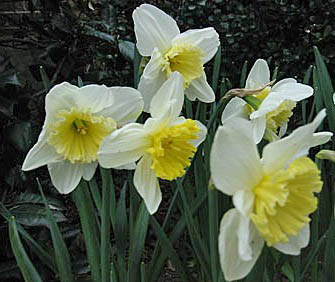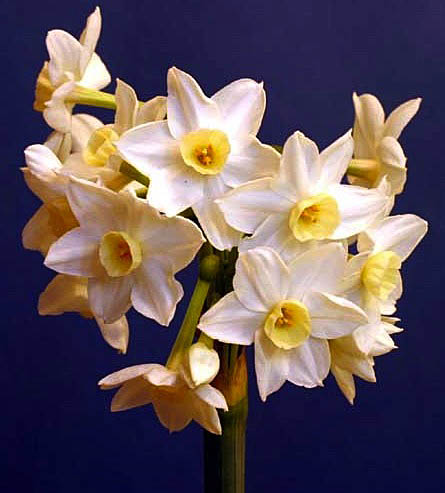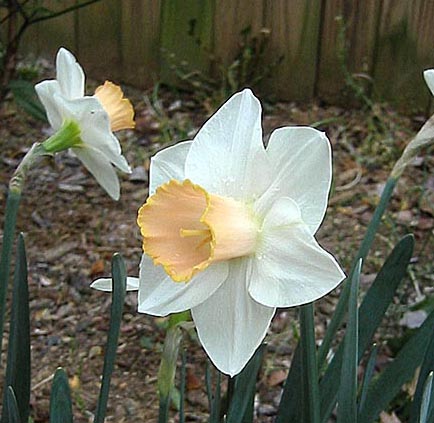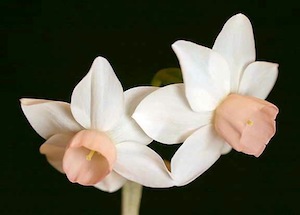Daffodils

Ice Follies, Division 2
by Mary Francis, Fairfax Master Gardener Intern
Each year winter grips us with bone chilling wind, grey days, ice and snow. We rejoice when snowdrops (Galanthus) and snow crocus (Crocus chrysanthus) bravely bloom. Are we really seeing more robins? We convince ourselves the grass must be slightly greener. Expectation now sits in the air. When daffodils (Narcissus) bloom we are finally certain: It is Spring!
The image of yellow trumpet daffodils is ubiquitous, yet there are more than 50 species of Narcissus and an astonishing 25,000 cultivars. Choosing daffodils can be a momentous task.

Early Pearl, Division 8
Fortunately for us, daffodils are described according to the system of the Royal Horticultural Society (RHS) of the United Kingdom by using three characteristics: “Division,” perianth segment (“petals”) colors and corona (“cup” or “trumpet”) colors. There are 13 Divisions, and six colors (white, green, yellow, pink, orange and red). The American Daffodil Society, American breeders and vendors typically use the RHS system.
The RHS Divisions
By taking a stroll through the RHS divisions, we gain an appreciation of daffodil diversity. Miniature daffodils have the same divisions, except the flowers are usually less than two inches.
| Daffodil Classifications | ||
| Division 1 | Trumpet Daffodil | The corona is as long as or longer than the perianth segment. There is only one flower per stem. |
| Division 2 | Large-Cupped Daffodil | The corona is more than one third but less than or equal to the length of the perianth segment. There is only one flower per stem. |
| Division 3 | Small-Cupped Daffodil | The corona is not more than one third the length of the perianth segment. There is only one flower per stem. |
| Division 4 | Double Daffodils | The flower has double petals and/or coronas. There can be one or more than one flower to a stem. |
| Division 5 | Triandrus Daffodils | These pendent flowers have reflexed petals (“bent back”). There can be one or more than flower per stem. |
| Division 6 | Cyclamineus Daffodils | The flower petals are significantly reflexed. The pedicicel (“neck”) of the flower is very short. There is a single flower per stem, with the flower at an acute angle to the stem. |
| Division 7 | Jonquilla Daffodils | The flowers are spreading or reflexed and are usually fragrant. There are one to five, and even eight flowers per stalk. |
| Division 8 | Tazetta Daffodils | The petals of the flower are spreading, not reflexed. The flowers are usually fragrant. There are three to twenty flowers to a stout stem. |
| Division 9 | Poeticus Daffodils | The petals are pure white. The corona is very short or disc-shaped, and not more than one fifth the length of the perianth segment. The corona usually has a green and/or yellow center and a red rim. The flowers are fragrant. |
| Division 10 | Bulbocodium Hybrids | The petals are insignificant compared to the dominant corona. There is usually one flower per stem. |
| Division 11 | Split-Cupped Daffodils | This division displays a split corona. |
| Division 12 | Other Daffodil Cultivars | These daffodils don’t fit into the other categories. |
| Division 13 | Daffodils Distinguished only by their Botanic Names, Wild variants, and wild-hybrids found in natural daffodils. | |

Trigonometry, Division 11a
The RHS Divisions are invaluable for selecting the desired appearance of the flowers. It is notable that flowers of Divisions 8 and 9 are mostly fragrant. Questions still abound for the curious gardener, however. When does a particular cultivar bloom and for how long? What is the height of the flower? Is the flower fragrant? Will a cultivar naturalize well?
Select Award Winning Cultivars
Selecting award winning cultivars is a good way to narrow choices. The American Daffodil Society (ADS) recognizes outstanding daffodils with the John and Gertrude Wister Award. The Royal Horticultural Society (RHS) presents the Award of Garden Merit (AGM) for Daffodils. Both are awarded annually.

Salome, Division 2
Use Internet Databases
The ADS website includes the database DaffSeek, which provides detailed information about thousands of cultivars. The RHS website has a wealth of information. The information includes height, fragrance and naturalization propensity. The databases are easiest to use if one has a particular cultivar under consideration.
Bloom Time
The bloom time for daffodils in zone 7 typically spans early March to early June, depending on the weather of a particular year. North Carolina State have published the results of daffodil trials that included recommended varieties for zone 7 based on bloom time. A few of their recommendations follow:

Akepa, Division 5
- Very early bloom
‘Ice Follies,’ ‘February Gold,’ ‘Unsurpassable’ - Early bloom
‘Browning,’ ‘Magnet,’ ‘Sugarbush’ - Mid-season
‘Flower Record,’ ‘Birma,’ ‘Tahiti’ - Late bloom
‘Salome,’ ‘Flower Drift,’ ‘Tresamble’ - Very late bloom
‘Geranium’

Geranium, Division 8
Forcing Daffodils
Daffodils readily lend themselves to blooming indoors by forcing. The bulbs can be refrigerated in a mesh bag in a vegetable or crisper drawer for 13 to 15 weeks, then potted and placed in a warm location (60 to 65 F). The bulbs bloom three to four weeks after cooling. Bulbs should not be stored near fruit because the ethylene gas produced by fruit may cause deterioration of the bulbs.
Recordkeeping
It is useful to have a short list of cultivars on which to rely. The criteria for selection can help gardeners create their own preferred lists for daffodil displays. It is recommended that one keep a record of successes and disappointments for future daffodil adventures.
Resources
Daffodil Divisions Using the RHS System of Classification, American Daffodil Society
Daffodil FAQs, American Daffodil Society
The John and Gertrude Wister Award, American Daffodil Society
DaffSeek-Daffodil Database with Photos, American Daffodil Society
RHS plant registration-Daffodil cultivars/RHS gardening, Royal Horticultural Society of the United Kingdom
Spring-Flowering Bulbs: Trials in North Carolina, North Carolina State Extension
List of Award of Garden Merit: Narcissus, Wikipedia